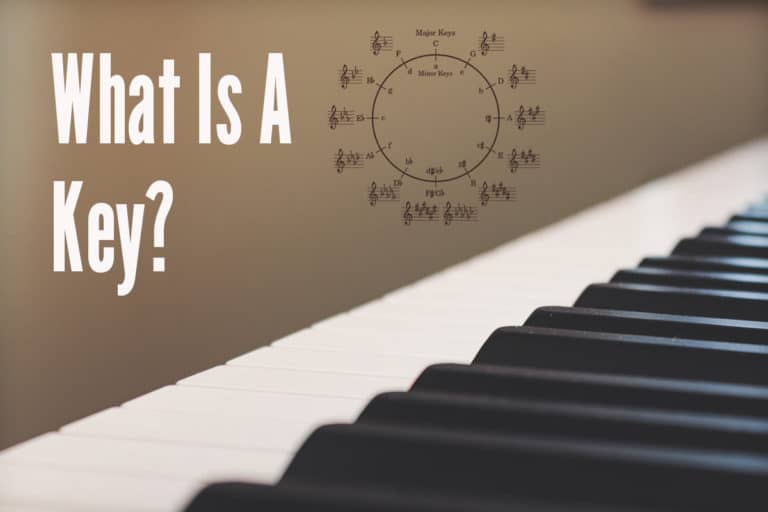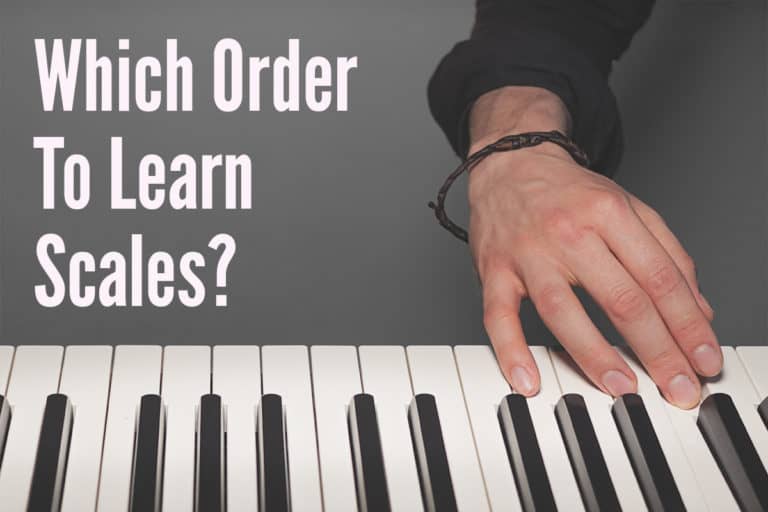Why You Should Always Memorize Scales
This post contains affiliate links.
Scales are an important part of learning and although this is a piano based site, most of this post will be applicable to many other musicians too. I’m sometimes asked by students whether you should completely memorize scales on your instrument or perhaps just learn to read them, learn how they’re built or even just play them for an exam and then forget about them.
You should memorize scales so they are easily recognized and feel natural to play or use in music. It is then much easier to avoid hitting any incorrect notes, whether playing by ear or reading. It helps you to learn new music quicker and to develop your technique and understanding of music theory.
To get the maximum benefit out of scales in ways that will help us ‘speak music’ more fluently and maximise our ability to learn, we need to really internalise them and get comfortable using them. There’s a bit more to understand so let’s take a look how to approach this and some specific reasons they will really help you become a better musician.
“If you’re playing music using a particular scale, then you absolutely need to know, fluently, what those notes are and where they are on the piano or whatever other instrument you’re learning.“
The Main Reason To Memorize Scales
The majority of music is written in a key, which is to say simply, that it uses the notes from a particular scale as the basis for the melody and harmony. Of course, music can go out the key too, change keys or not really use a key at all, but either way, scales are the backbone of much music and so they’re really important for musicians to understand. For more depth on what it really means to be in a key, you can read this article.
If you’re playing music using a particular scale, then you absolutely need to know, fluently, what those notes are and where they are on the piano or whatever other instrument you’re learning. You can then lock into that scale, you can navigate through the notes comfortably and without hesitation or playing any wrong notes.

Beginners, in particular, can often think that learning or memorizing a scale simply means being able to recite it up and down in one or perhaps multiple octaves, learning the correct fingers and basic technique along the way. This isn’t untrue, that’s an important thing to be doing. It’s probably the best place to start and will take you far. We just need to take it further.
The problem is that you may end up getting stuck in that specific habit and pattern of only playing the notes in order from the starting point. In reality, you may then get lost when music uses the notes of a scale and creates all kinds of patterns and chords within it.
Here’s a few common scenarios and exactly how being as fluent as possible with your scales will help you improve.
Reading Sheet Music
Written notation uses ‘key signatures’ which tell you what scale or key you’re in. They show you at the start, which notes become sharps or flats. It’s entirely possible to just think of those specific notes you need to change but it’s far more efficient and simpler in the long run to know what scale to use for a given key signature and be able to see exactly where that is on your instrument.
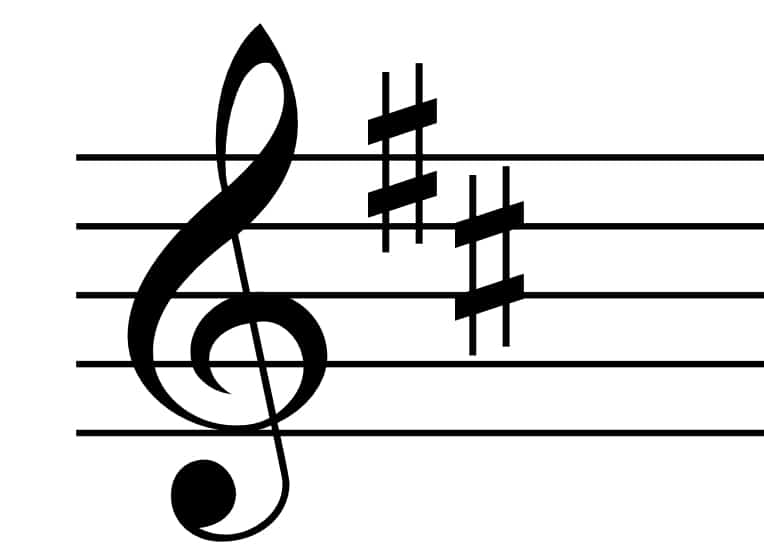
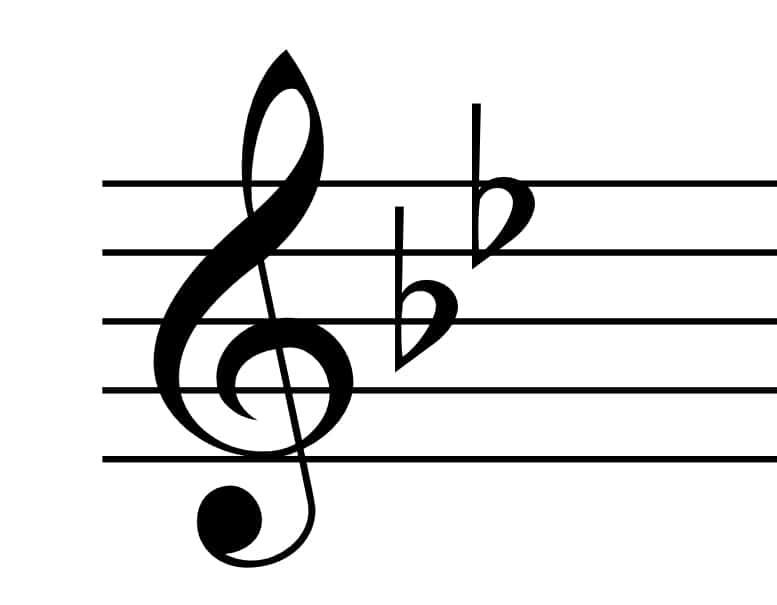
When the dots on the page move up and down on the staff, they move up and down inside the key, inside the scale you’re locked into (Unless it specifically tells you to go out the scale with an accidental, of course).
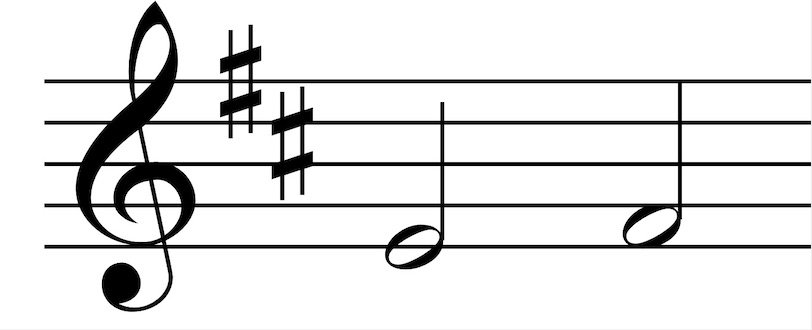
In this example, we’re in the key of D major which has an F#. If the current note is an E and you can see the next note moves up a 2nd, (to the note next door) being familiar with the scale means you already know and see the next note should be F# instead of F natural. You’ll play it without thinking.
Now that example is still probably quite easy either way, but with scales that have more flats and sharps and when the music gets more involved, it really pays off to not have to think about what notes you’re meant to be using. You can become so much more familiar and quicker at reading with this method and it’s easier to keep track of where you are on the keyboard, spot patterns and understand what you’re playing.
When you can easily visualize the shape of the scale, it’s also much easier to keep track of how the music works or moves around in the context of that scale.
Learning And Memorizing Songs And pieces
There’s 12 notes on the piano but there’s only 7 in most scales you will use, for example major and minor scales. If you know what key you’re in and you’re trying memorize a piece of music, that narrows it down already to a particular shaped stream of notes that you’ll, for the most part, be working with.

When you can easily visualize the shape of the scale, it’s also much easier to keep track of how the music works or moves around in the context of that scale. It will feel more cohesive, like it makes more sense and speaks in a language you understand to see the notes as part of the scale.
You can become familiar with patterns, with which degrees of the scale are used as well as how it sounds and feels under your fingers to navigate. All this combined can make a huge difference in your capacity to learn and memorize all different kinds of music.
Improvisation
One of the hardest things about improvisation is knowing what notes you can use that will sound good. Many musicians will start by learning to improvise within a scale, getting familiar with the sound of it and what they can do with it. It goes without saying then that to create something of your own with a specific selection of notes, you must memorize and be familiar with those notes! They are your vocabulary with which to form your own sentences.
Of course there’s many approaches to improvisation and this is just one, but even when things get more complicated or go outside, there’s often an element of basing what you play around a key or a scale. The scale helps you narrow the search for the notes you hear in your head!
Working Out Music By Ear
Not exactly the same, but similar, is using a scale to help transcribe a piece of music, which means to figure something out by ear. This could apply to finding the notes in your head too if you have just thought of a melody and are trying to play it on an instrument.
Again, the scale gives you context. If a melody or a chord progression, for example, sounds like it sticks in a major scale, then if you are comfortable in that scale and can lock into it, you instantly know where to look on your instrument to find the correct notes and what notes to avoid. It’s a much more organized, clear way of doing things and you’re far less likely to get confused or stuck.

With practice you can also hear patterns in the scale, how far notes leap within the scale, exactly where in the scale they are and also when a note moves outside of the scale adding a new colour to the sound.
Memorizing Scales Helps You Develop Better Technique
Often, the first step in learning a new piece of music is just learning the notes. When you can read the notes easily enough or have them memorized, then you can begin to focus on how you’re playing; on your fingers, your technique, your performance and all of those elements.
When you’re still hesitating and stumbling over just finding the notes, there’s no way you can be training your hands properly. As we already talked about, memorizing scales can help you learn music more efficiently. The side effect of that is that you will be able to put more of your brain power and energy on developing your technique, it’s easier to relax your hands, think ahead and move smoothly between the notes.
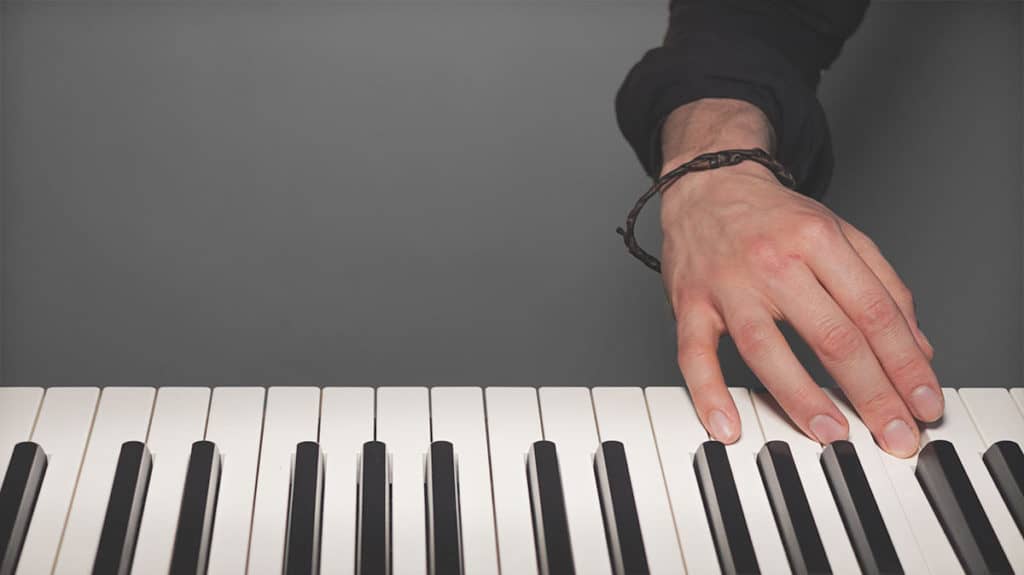
This is also true of just playing scales themselves. We do this sometimes to hone our technique and speed, for example. You can’t play smooth or fast if you’re thinking too hard about what the notes are, the shapes and fingers must be internalised.
Memorizing Scales Helps You To Understand Music Theory
Understanding the basics of music theory can supercharge your musicianship and the amount and speed at which you’re able to learn. Not instantly, but eventually it makes a huge difference with many aspects of your ability including reading, memorizing and playing by ear.
The thing about learning music theory though is that it’s important to be able relate it to your instrument. When you’re really comfortable visualizing scales, it helps you start to see how the music that you’re playing really works.
You can see, for example, what degrees of the scale are being used, which chord numbers are in the progression, how the chord is voiced or how the melody relates to the harmony. Without the context of a key or scale, this kind of thing can be very confusing and unclear.
Learning scales helps you spell notes correctly too. For example, whether in a particular key you need to use F# or the enharmonic equivalent Gb. This is another aspect of music theory that makes the learning process clearer.
Which Scales Are Most Important To Memorize First
There are many different types of scale but some are less common and with different instruments, it makes more sense to start with certain keys.
So which scales should you learn first on piano? Major scales are the most common and useful scales to learn first. On piano, start with C major. It has no flats or sharps and is the easiest to play or read. After a few major scales like G, D and A, you need to learn some minor scales too. There are different types but start with A natural minor.
Major scales provide you a solid grounding in technique, plus a foundational understanding of theory and chord progressions on the keyboard. You don’t need to learn all 12 before moving onto a few minor scales but eventually you’ll want to complete the set.
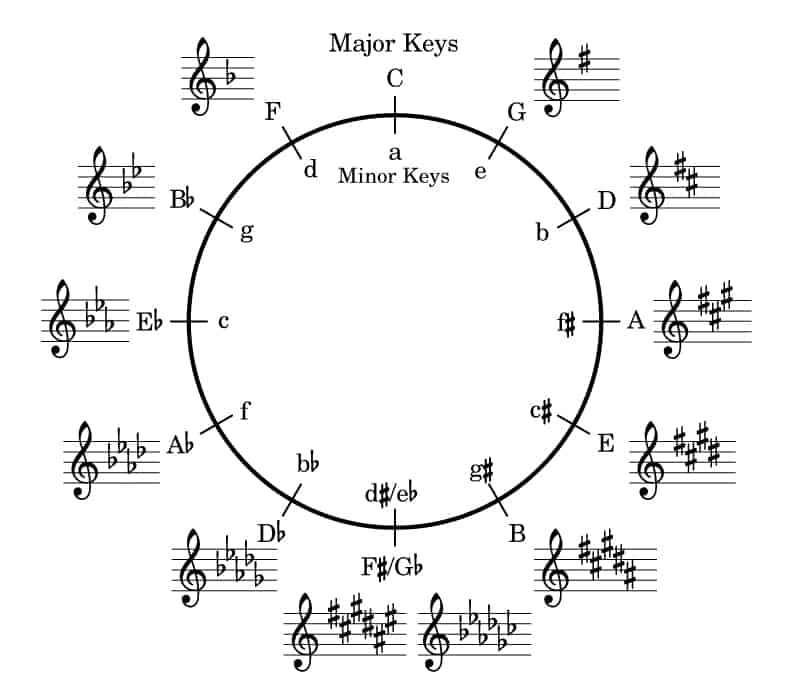
It makes most sense to start with C and then work your way around the circle of 5ths, gradually adding a new sharp each time. This way, we’re gradually increasing the visual (and reading) complexity plus for 5 keys, you get to use the same finger patterns! There’s no perfect order so after 2 or 3, you could also perhaps make your way around the flat side of the circle of 5ths learning F (1 Flat) then Bb (2 Flats) and so on. These will require new finger patterns.
I have a PDF worksheet available for download here containing graphics, notation, finger numbers and theory for all 12 major scales, plus more. Here’s some preview pages:
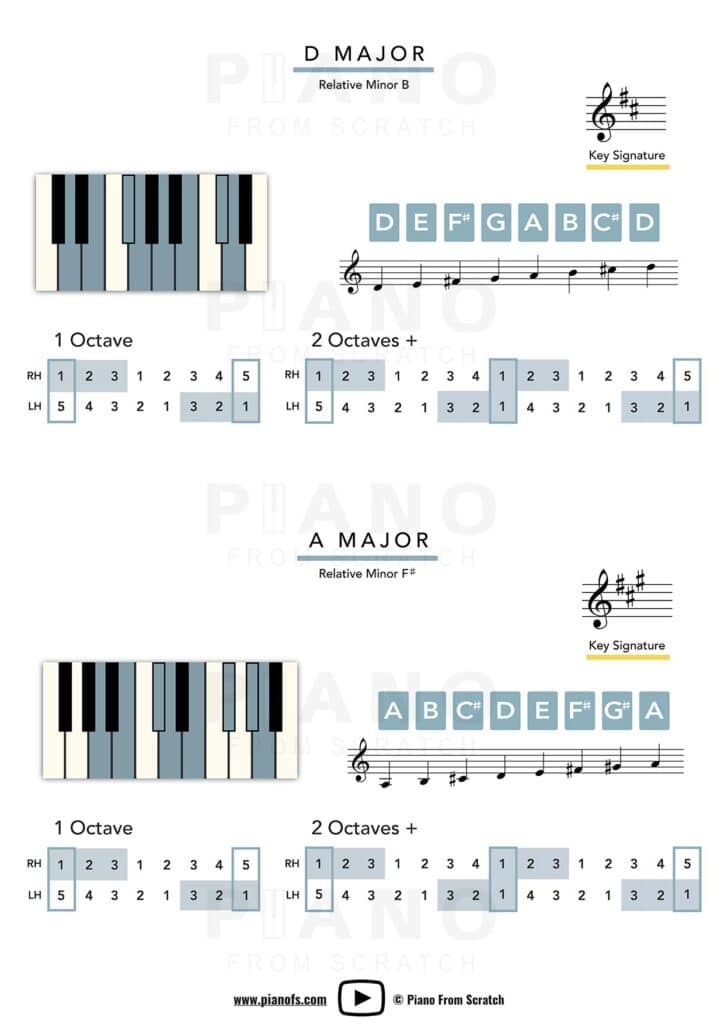
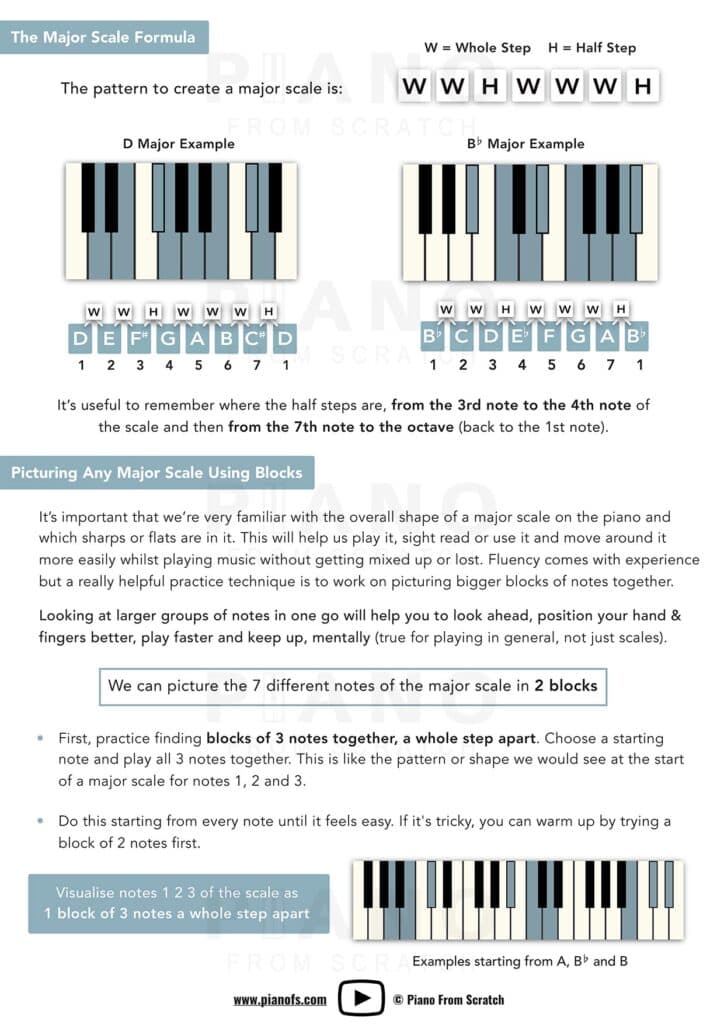
There’s a few different kinds of minor scales but it’s best to start with natural minors then you can learn to adjust them to create the variations. To understand everything you need to know about minor scales, I have an in depth 3 part series over on my YouTube channel you can WATCH HERE or take a look at the minor scales theory PDF worksheet.
For a more in depth look at which order to learn scales then you can read this article here.

How To Memorize Scales Better
With Theory
Make sure you first learn how a major scale is built, in terms of the intervals used. This is FUNDAMENTAL musical knowledge you must learn. Essentially, it uses all the major and perfect intervals. If that doesn’t makes sense at this stage, you can watch this video below which explains everything you need to know!
Learning how to spell the scale correctly is important too (whether to use F# or Gb for example) as well as recognize a scale by how many sharps or flats it has in the key signature. See the circle of 5ths image above.
Using Blocks Of Notes
A method I teach is to learn to see the major scale pattern clearly and easily in all 12 keys, learn the interval names and then practice how to adapt that pattern on your instrument to create a new scale. This saves constantly memorizing 12 versions of everything and lets you better understand the new scales at the same time.
The pattern to find a major scale using half steps and whole steps in WWHWWWH and most people teach this but in reality, it’s not very practical. It means you end up thinking step by step too much and you need to be thinking ahead more. It’s much better to visualize blocks of notes on the keyboard!
I have a unique, practical method for doing this you can watch below to really help you memorize scales on the keyboard in every key much more easily.
Practice In All 12 Keys
A lot of the time scale practice will focus on technique, and that’s really important, but sometimes just make the intent of your practice to be focused on memorizing and finding scales in all keys (Or as many as you know so far)
For example, practice all major scales one after the other in succession, but perhaps slowly in one octave and hands apart. This way your mind is bent on finding those shapes and mentally being able to switch from key to key at a fast pace as opposed to playing them with perfect technique or quickly.
Improvise In That Key
Whatever level you’re at, a bit of improvisation in a particular scale will get you really familiar with the shapes and the notes of that key and how to move around it, in a really tactile way.
Pay Attention To How A Scale Is Used In Music
You must remember to analyze what you’re playing. Even if you can play a scale from memory without a hitch, you have to engage your brain a bit to think about what’s happening and how it’s used in the context of a piece of music. Just noticing simple things like a melody beginning on the 5th note, for example, is helpful. Beginners sometimes even forget what key they’re in and lose all context so at least remember the root!
It’s easy for us to get in the trap of just memorizing music by the individual notes used. If you take the time to examine how those notes relate to the scale, or perhaps whether they go out the scale, in the long run you will start becoming far more fluent in the language of music and how certain sounds are made, plus of course, get really familiar with that scale.
Don’t Rely On Sheet Music To Memorize Scales
By all means, you can learn what the notes are for the first time or recap them if you’re stuck however you like. Relying on notation every time you come to practice, however, will slow you down from memorizing them.
Memorizing Scales By Sound
Each new type of scale is a unique palette of sounds with which we can create music. A major scale, a natural minor, a harmonic minor or anything else, all have different tonalities we should get familiar with as we learn them. Aside from simply listening actively and taking note of the sound, singing or humming scales will help engrain it as well as associating specific pieces of music with a type of scale.
What Memorizing A Scale Really Means
To have memorized and understood a scale fully means you are fluent recognizing, and using those notes in a variety of contexts. Essentially, being able to lock into that scale, play all the right notes and keep track of where in the scale you are, whatever you’re doing.


